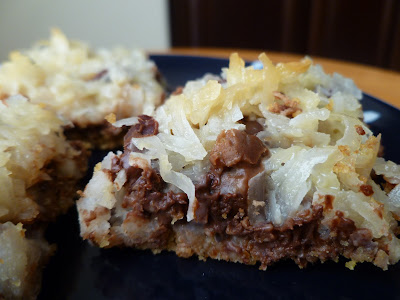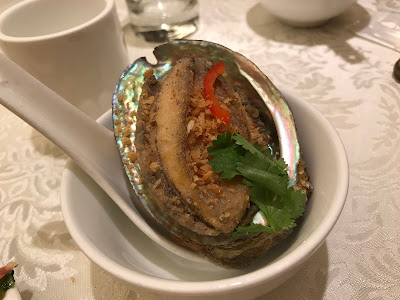Mike, one of my coworkers, and I got into a conversation about desserts one day. His preference was for French sweets such as macarons, mille-feuilles and canelés . I’m not shy about declaring macarons are too sweet for me but I don’t mind mille-feuilles and canelés. I rarely make either of them though since mille-feuilles are a pain in the flaky-pastry-handling butt and I never got into caneles because the canelé molds are so expensive. He was a little appalled that I, a prolific baker, didn’t like his preferred desserts and didn’t make them.
 |
| Custard mixture with vanilla bean |
I researched recipes on the internet for canelés, i.e. I stalked pinterest. In looking at the different recipes, it was easy to discover the ingredients are nearly identical in each recipe. It appears the tricky part of making canelés is the actual process of making them. I will spare you all the different blogs I researched and just give you the highlights:
- Use real vanilla beans
- Plan to make the batter at least two days before you’re going to serve the canelés. The batter must rest in the refrigerator before using. Some recipes say 1 day is okay, others recommend at least 2. No more than 4 days.
- Bake at extremely high heat for the first 10 minutes (500-550 degrees) then lower the temperature to 375 degrees for the remainder of the time, depending on the size of your canelé.
After all the dire warnings about what can go wrong with canelés, I was a little nervous on my maiden run with them. Making the custard itself was easy and just like making pastry cream but even easier since you didn’t have to try and thicken it. Just make sure you temper the eggs with the hot liquid mixture.
I will confess to one “oops”. The first recipe I used was European in origin and I had to translate what they meant into American ingredients. Based on prior experience, I thought I got everything right. But I made one mistake in thinking “full cream milk” was heavy cream. I found out later it meant whole milk. By then it was too late (Day 2 in the fridge) because I’d already made it with heavy cream, not milk. My coworker Eileen reasonably asked why I hadn’t checked google first when I confessed my sins. Me: I thought I knew more than Google. It appears I was wrong.
Other than that mistake, the rest of the recipe process went surprisingly smoothly. I didn’t have the mushrooming issue that other canelé recipes warned darkly about. I didn’t overfill the silicone molds and when I popped them out of the oven and turned them over, they looked like actual honest-to-goodness canelés. Who knew they were so easy to make?
One cautionary note: it’s hard to tell when they’re done since these are custard desserts. They’re baked upside down so all you can see on top are the bottoms. The bottoms will brown quickly but you want the whole canelé outer crust to be evenly browned and that means baking them long enough. If you underbake them, not only will the outer shell be too pale but your custard inside will be runny. So this is one of the desserts where I recommend timing them in the oven.
The other thing to know about finicky canelés is they’re best eaten the day they’re baked. When freshly baked and completely cooled, the outer part is a crisp shell and contrasts nicely with the softness of the inner custard. Because the ingredients are so similar, the canelés reminded me of pastry cream but baked with a shell. Because that’s essentially what they are. My mistake with the heavy cream/whole milk issue notwithstanding, I have to say I enjoyed these. Uh oh. Wait for the next post.
500 ml (2 cups) heavy cream (or you can use whole milk like you're supposed to)
50 g (1.8 ounces) butter
1 vanilla bean
100 g (3.5 ounces) all-purpose flour
250 g (9 ounces) powdered sugar
1 teaspoon salt
2 eggs
2 egg yolks
60 ml (1/4 cup) rum
- Place the milk, butter and vanilla bean in a small saucepan; bring to a boil. Remove the pan from the heat and cool slightly. Remove vanilla bean and set aside for later use.
- Place the flour, powdered sugar and salt in a large mixing bowl.
- Place the eggs and egg yolks into a separate bowl and beat lightly. Add gradually to the dry ingredients, whisking slowly to incorporate. Gradually add the cream mixture, whisking to incorporate each addition until smooth and combined.
- Strain the batter into a clean bowl. Add the rum, whisking until combined. Return the vanilla bean to the mixture, cover the bowl with plastic wrap and refrigerate for at least 2 days and up to 4 days.
- If using a silicone mold: Preheat oven to 460 degrees F (check the instructions on your silicone mold pan - mine says it can only go up to 446 degrees F). Place the silicone mold on a baking sheet and heat it in the oven for 4-5 minutes.
- Remove the batter from the refrigerator and stir gently. Pour the batter into the molds, leaving a 1 cm border from the top.
- Bake for 15 minutes then reduce the oven to 375 degrees F and bake for another 1 hour until the cakes have achieved a golden brown color. Remove the canneles immediately from the molds and cool on a wire rack.
- If using copper molds: preheat oven to 460 degrees F. Place the molds on a baking sheet and heat in the oven for 4-5 minutes. Generously grease the molds with melted butter.
- Remove the batter from the refrigerator and stir gently. Pour the batter into the copper molds, leaving a 1 cm border from the top.
- Bake for 15 minutes then reduce the oven temperature to 375 degrees F. Bake for another 45 minutes until the cakes have achieved a golden brown color. Remove the canneles immediately from the copper molds and cool on a wire rack.































































